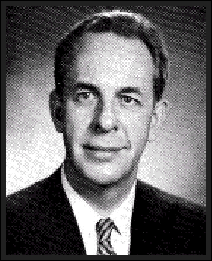
Home Page

 Next Article
Next Article
 Previous Article
Previous Article
 Table of Contents
Table of Contents
 Author Index
Author Index
 Title Index
Title Index

MICHAEL EDMUNDS

 Home Page 
 Next Article Next Article
 Previous Article Previous Article
 Table of Contents Table of Contents
 Author Index Author Index
 Title Index Title Index

|
MICHAEL EDMUNDS Barrington Nevitt 1907-1995 |

|
|
|
Barry and I entered the building and were faced with that art
deco of a staircase. He grabbed the railing with his left hand
positioned me so that he could lay his right hand upon my shoulder
and the two of us, as one, climbed. There was no way that Barry
was going to be denied a chance to continue exploring the laws
of the media, an odyssey that he had begun as a young man first
learning and working with radio and then, after a career in telecommunications,
collaborating with Marshall McLuhan through the 60 and 70's producing
articles and books, particularly the important Take Today: The
Executive as Dropout that he co-wrote with Marshall.
It was in the late seventies when I first met Barry. It was at the coach house, the home of the Centre for Culture and Technology. Marshall was popping open cases of Take Today (recently arrived from the publisher's remaindered bins) and he and Barry were autographing them for students in Marshall's graduate seminar. Barry's affinity with students and younger people was re-emphasized for me in the summer of 94, Barry's last summer, when Roland Edmunds, my son, had an art exhibit. In true form Barry was the first to arrive and was among the last to leave. I expressed my appreciation to Barry for coming out and supporting Roland. "Well, you see," said Barry, "we {the older set} have to come out and give what we can to the young people. It's important that they see and understand what we have to offer so that they can build upon that." It was that ability in him to reach out to and draw-in, if necessary, fellow explorers that Barry exercised until his last moments. Barry worked very hard his last five years to publish a book on McLuhan and achieved his goal in the fall of 1994 with the launch of Who Was Marshall McLuhan? In the preparation and distribution of that book Barry wanted to show the impact of McLuhan's ideas upon a group of explorers. However, as much as Barry was committed to continuing the work that he and Marshall and others had started, he was also interested in remembering and honouring his colleague. Who Was Marshall McLuhan? was Barry's way of creating a tribute to Marshall. That it was important to him was evident from his single-mindedness to see the project through to the end, in spite of numerous setbacks. One day as we were talking something came up about Marshall and him. As the talk inevitably turned to the good old days, Barry in his unassuming way said, "I miss him. We were pals." After all the thoughts and writing on communications and technology, the meetings and conferences, the plans and dreams it came down to, "I miss him. We were pals." For those of us who worked with and shared our thoughts on communications and technology with Barry Nevitt, we too can say, We miss him. We were pals. | |
